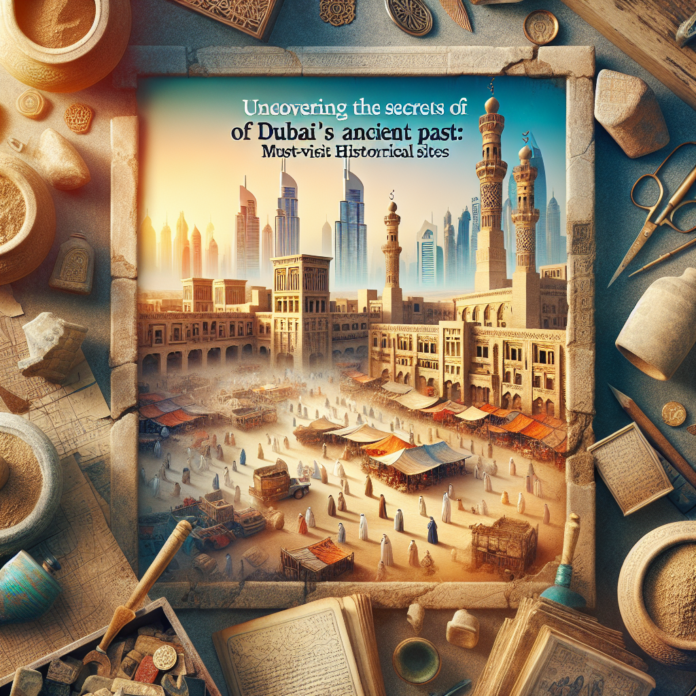[ad_1]
Dubai may be known for its modern skyscrapers, luxury shopping malls, and extravagant lifestyle, but the city also has a rich history that dates back thousands of years. From ancient archaeological sites to historical museums, there are many places in Dubai where you can learn about the city’s fascinating past. In this article, we will explore some of the must-visit historical sites in Dubai and answer some frequently asked questions about the ancient history of the city.
Must-Visit Historical Sites in Dubai
1. Al Fahidi Fort
Al Fahidi Fort, also known as Dubai Museum, is one of the oldest buildings in Dubai and is a must-visit for history enthusiasts. The fort was built in the late 18th century and was originally used as a defense outpost to protect the city from invading forces. Today, the fort has been transformed into a museum that showcases the history and culture of Dubai through exhibits and artifacts.
2. Dubai Creek
Dubai Creek is a natural seawater inlet that divides the city into two parts – Deira and Bur Dubai. The creek has played a vital role in Dubai’s history as it was a hub for trade and pearl diving in the past. Visitors can take a traditional abra (water taxi) ride along the creek to experience the city’s ancient trading routes.
3. Jumeirah Archaeological Site
The Jumeirah Archaeological Site is an important historical site in Dubai that dates back to the Abbasid period (8th to 10th centuries AD). The site contains the remains of a mosque, a fortress, and several houses that provide a glimpse into the daily life of Dubai’s early inhabitants. Visitors can explore the site and learn about the city’s early Islamic history.
4. Bastakiya Quarter
The Bastakiya Quarter is a historic neighborhood in Dubai that has been preserved to reflect the city’s traditional architecture and culture. The narrow lanes and wind-tower houses in Bastakiya offer a glimpse into Dubai’s past before the modernization boom. Visitors can wander through the alleys and visit art galleries, museums, and cafes in this charming area.
5. Hatta Heritage Village
Hatta Heritage Village is located in the Hajar Mountains, about 115 kilometers from Dubai city. The village is a restored heritage site that showcases traditional Emirati culture and architecture. Visitors can explore the mud-brick houses, watch demonstrations of traditional crafts, and learn about the history of the region.
FAQs about Dubai’s Ancient History
Q: How old is Dubai?
A: Dubai’s history dates back over 4,000 years when it was a small fishing village and trading port. The city has witnessed significant development over the centuries, transforming from a humble settlement to a global metropolis.
Q: What was Dubai’s main economic activity in ancient times?
A: In ancient times, Dubai’s main economic activities were pearl diving, fishing, and trade. The city’s strategic location along the Arabian Gulf made it a crucial trading hub for goods such as spices, textiles, and pearls.
Q: Who were the early inhabitants of Dubai?
A: The early inhabitants of Dubai were primarily Bedouin tribes who settled in the area around the 7th century AD. They were nomadic people who relied on fishing, herding, and trading for their livelihood.
Q: What is the significance of Dubai Creek in the city’s history?
A: Dubai Creek played a vital role in the city’s history as it was a center for trade, fishing, and pearl diving. The creek was also instrumental in connecting Dubai to other regions, making it a prominent trading port in the Arabian Gulf.
Q: How has Dubai’s history influenced the city’s modern development?
A: Dubai’s history has played a significant role in shaping the city’s modern development. The city’s heritage and culture are preserved through historical sites and museums, while modern infrastructure and technology have transformed Dubai into a global business and tourism hub.
Overall, Dubai’s ancient past is a fascinating aspect of the city’s history that is worth exploring. By visiting historical sites and learning about the early inhabitants of Dubai, visitors can gain a deeper appreciation for the city’s rich heritage and cultural significance.
[ad_2]


